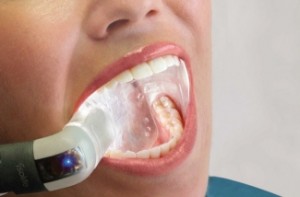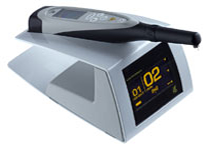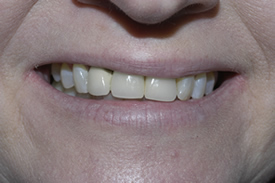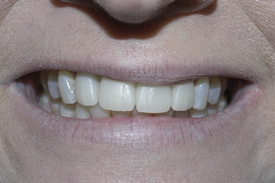General Dentistry
Our practice provides dental services for the entire family. To save time for our family of patients, we try to coordinate appointments with multiple family members. To help restore your mouth to health, we will eradicate decay and gum disease, provide nutritional counseling and help you find ways at home to maintain a healthy mouth.
Composite Fillings
 We only use composite resin material or tooth colored material for our fillings. If you have older silver fillings that need to be removed or replaced, we will take preventive measures to ensure the old alloy that we are removing is not ingested. We use a special Isolight system that will suction all of the loose alloy particles during the removal procedure. We practice conservative dentistry and only remove areas of decay from the tooth.
We only use composite resin material or tooth colored material for our fillings. If you have older silver fillings that need to be removed or replaced, we will take preventive measures to ensure the old alloy that we are removing is not ingested. We use a special Isolight system that will suction all of the loose alloy particles during the removal procedure. We practice conservative dentistry and only remove areas of decay from the tooth.
Laser Cavity Detection
 We use the DIAGNOdent laser cavity detection system in our office. Our laser decay detection system enables us to catch tooth decay several years before it would be seen on a radiograph or detected clinically. This laser detection system allows us to be very conservative and precise when removing the decay. A new filling will be bonded in place and will look seamless with the rest of your tooth.
We use the DIAGNOdent laser cavity detection system in our office. Our laser decay detection system enables us to catch tooth decay several years before it would be seen on a radiograph or detected clinically. This laser detection system allows us to be very conservative and precise when removing the decay. A new filling will be bonded in place and will look seamless with the rest of your tooth.
Our office uses a combination of laser cavity detection, intraoral photos and radiographs to help detect decay. To guard against false readings with the laser alone, we use intraoral cameras that take a close up photo of the tooth to make sure that we are not getting a false reading with our laser due to a old filling or sealant.
How Does the DIAGNOdent Work?

DIAGNOdent is a pen-like probe that sends a safe, painless laser beam into the groove of your tooth and checks for open spaces or cavities that a normal instrument cannot reach. The DIAGNOdent gives off a number reading which communicates how large the cavitation under your groove is. If you have a low reading there is a chance that the small area of decay can be reversed with better home care and nutrition. The laser allows us to detect hidden microscopic decay that otherwise could not be found under the hard outer surface of your enamel.
Digital Radiographs
Our office has four treatment rooms which are equipped with low dose x-ray machines. We use digital sensors for our radiographs which emits less radiation than traditional film radiographs. Once you are a new patient in our practice, we let your decay rate dictate how often we need to take new radiographs of your teeth in order to sustain a healthy smile.
Oral Abnormality Screening
Oral cancer in on the rise and we are prepared for this at our office. We perform a detailed extraoral and intraoral screening at your new patient exam and at each of your hygiene appointments. We also have a VELscope® which does a deeper scan of your mouth for oral abnormalities.
Root Canals
Root canals are needed in cases of trauma, nerve damage, deep decay or fracture when the nerve of the tooth is damaged. A root canal or endodontic therapy treats the inside of the tooth when the dental pulp becomes inflamed or infected. During endodontic therapy the inflamed or infected pulp of the tooth is removed and the inside of the tooth is carefully cleaned and disinfected. We will then fill the tooth with a filler and sealer material called gutta-percha. After a root canal a tooth will function normally. With proper home care, most teeth that have had a root canal can last as long as a natural tooth.
Root canal procedure:
- Anesthetic used to numb the tooth
- Rubber dam placed to isolate the tooth
- Small access hole made in back or top of the tooth
- Small files are used to clean and remove infected nerve or pulp tissue
- A filler material is used in the canal and chamber
- A final filling is placed in the access hole
- A crown/onlay is placed if it is needed
Tooth Extractions
A tooth extraction, also known as exodontia, is one of the most common procedures performed at a dentist's office. The extraction of a tooth may be recommended for the following reasons:
- Wisdom teeth
- Decayed teeth
- Broken teeth
- Overcrowding
- Loose teeth
- In preparation for braces
The tooth extraction procedure may require removal of soft or hard tissue, depending on whether the tooth is fully erupted. The extraction is performed with either local or general anesthetic.
After the extraction, stitches may be necessary; alternatively, a dental implant, bridge or denture will be used to replace one or more teeth.
Dental Crowns and Bridges
Dental Crowns
Dental crowns are natural-looking, tooth-shaped caps used to cover a damaged or missing tooth in order to restore a full and beautiful smile. These caps are cemented into place to provide both strong and visibly appealing replacements for natural teeth. Crowns are usually necessary when the tooth is broken down to the point where a filling will not be effective.
A dental crown can be used for various reasons, including covering discolored or misshapen teeth, and in conjunction with bridges and dental implants.
Other benefits of dental crowns may include:
- Holding a cracked tooth together to prevent further damage
- Covering and supporting a tooth with a large filling
- Restoring a broken tooth
There are several different methods of crown restoration, each using a different crown material. Different types of material used for crowns include metal, porcelain, ceramic and resin. These materials may also be used in combination.
Dental Bridges
Dental bridges are natural-looking tooth replacements that help maintain facial structure, reduce stress on the jaw and fill in the gaps caused by missing teeth. Bridges may be removable or may be fixed by cement to the existing teeth.
A dental bridge can be used to:
- Restore the patient's original smile
- Reduce the risk of gum disease
- Restore the ability to bite and chew
- Improve speech
- Prevent the remaining teeth from drifting out of position

Before

After
Nightguards
Bruxism, more commonly referred to as the grinding or clenching of teeth, is a subconscious habit responsible for causing temporomandibular joint (TMJ) problems as well as the wearing down of teeth.
While bruxism is very common, its origin differs from patient to patient and is most often associated with anxiety and stress. Despite its widespread occurrence, many people who suffer from bruxism are not even aware of the problem since most people only experience it while asleep. Although symptoms may not always be present, there are a number of clues that may signal you are suffering from bruxism:
If it is determined that you suffer from bruxism, we can custom fabricate an appliance (nightguard) that can be worn during sleep or at home. This comfortable appliance will help prevent damage to your teeth and alleviate any of the discomfort associated with bruxism. If the condition persists, we will suggest a number of treatments and relaxation methods that may resolve the condition.
